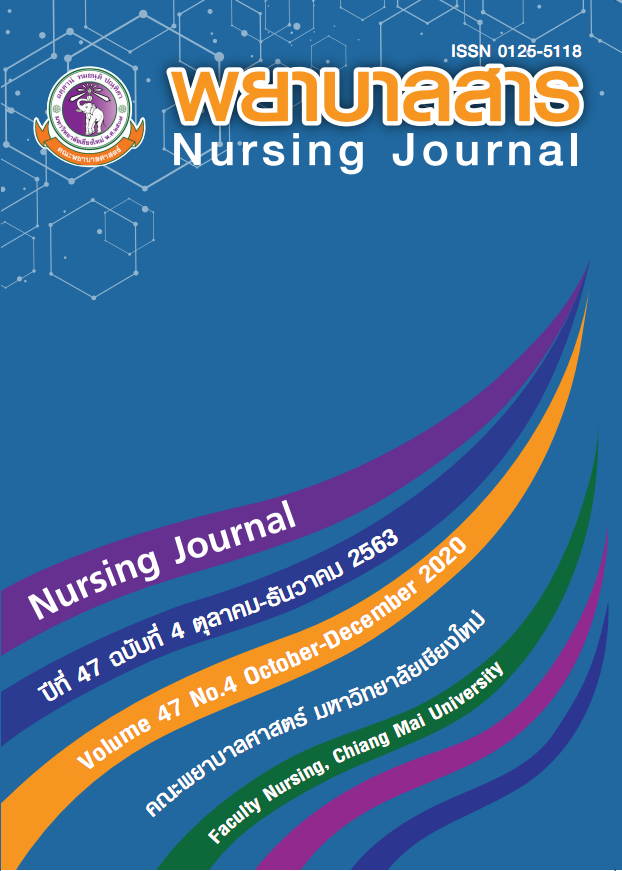The Study of Time Spent on Nursing Activities in Operating Room, Lampang Hospital
Keywords:
time spent on nursing activities, nursing activities, operating roomAbstract
The time spent on nursing activities is important information to nurse staffing. The purpose of this study was to analyze nursing activities according to the nursing needs of each type of patient and study the number of hours spent by nurses performing nursing activities for each type of patient in the operating room at Lampang Hospital.The sample were 8 registered nurses working in cardiac vascular and thoracic surgery departments at Lampang Hospital and 58 patients who received surgery services from the operating room at Lampang Hospital during the time of this study. The tools used in this study contains a dictionary of surgical nursing activities the content validity index of 0.80. And a recording of the amount of time that nursing personnel spend in nursing activities the interobserver reliability of 0.93. Applying the step of the nursing staffing planning process of
Srisathidnarakul (2007). Patient classification according to the Patton (2002) concept. And patient classification based on nursing activities according to the Connor (1961). Data were analyzed using descriptive statistics.
The result showed that
- Nursing activities of major patients total 39 activities and minor patients total 27 activities
- Time spent on nursing activities in major patients was 7 hours 11 minutes, with time spent on direct nursing activities was 5 hours 48 minutes. Time spent on indirect nursing activities was 1 hour 23 minutes. Time spent on nursing activities in minor patients was 2 hours 26 minutes, time spent on direct nursing activities was 1 hour 45 minutes and time spent on indirect nursing activities was 41.15 minutes
The results of this study are basic information for managers to use as a basis for calculating staffing.
References
Srisathitnarakun, B. (2007). Leadership and management strategies of nursing organizations in the 21st century (2nd ed.). Bangkok: Chulalongkorn University. (In Thai)
Conner, R. J. (1961). A work sampling study of variations in nursing workload. Hospital, 35(1), 40-41.
Moosa, F., Chontawan, R., & Akkadechanunt, T. (2016). Factors Related to Intent to Stay Among Nurses in the Tertiary Hospital, Maldives. Nursing Journal, 43(2), 129-141. (In Thai)
Boonyasanti, N. (2017). Factor Associated with Length of Stay’s of Heart Surgery Patients in Chonburi Hospital. Chonburi: Heart Center Unit, Chonburi Hospital. (In Thai)
Omachonu, V. K., & Nanda, R. (1989). Measuring productivity: Outcome vs. Output. Nursing Management, 20(4), 35-40.
Patton, M. R. (2002). Management of perioperative clients. In D. D. Ignatavicios & M. L. Workman (Eds.), Medical-surgical nursing. Philadelphia: W.B. Saunders.
Permpech, R. & Butsripoom, B. (2016). The Role of Perioperative Nurse: Health Education for Pre and Postoperative Visiting. Ramathibodi Nursing Journal, 22(1), 9-20. (In Thai)
Nantsupawat, R., Wichaikhum, O., & Nantsupawat, A. (2014). The Relationship between Nurses’ Extended Work Hours and Patient, Nurse, and Organizational Outcomes in General Hospital. Nursing Journal, 41(4), 58-69. (In Thai)
Shumaker, R. P. (1997). Perioperative nursing. In J. M. Black, & E. Matassarin-Jacobs (Eds.), Medical-surgical nursing. Philadelphia: W.B. Saunders.
Thengkiattrakul, S., & Butsripoom, B. (2016). Perioperative Nursing (2nd ed.). Bangkok: Mahidol University. (In Thai)
Pokpermdee, P. (Ed.). (2018). Twenty-Year National Strategic Plan for Public Health (2017-2036). Bangkok: Strategy and Planning Division.
Chimanagran, W. (2006). Perioperative Nurse Staffing, Saraburi Hospital (Master’s thesis, Chulalongkorn University). (In Thai)
Yilmaz, M., Sezer, H., Gurler, H., & Beker, M. (2011). Predictors of preoperative anxiety in surgical inpatients. Journal of Clinical Nursing, 21(7-8), 956-964. doi:10.1111/j.1365-2702.2011.03799.x
Downloads
Published
How to Cite
Issue
Section
License
บทความที่ได้รับการตีพิมพ์เป็นลิขสิทธิ์ของวารสารพยาบาลสาร
ข้อความที่ปรากฏในบทความแต่ละเรื่องในวารสารวิชาการเล่มนี้เป็นความคิดเห็นส่วนตัวของผู้เขียนแต่ละท่านไม่เกี่ยวข้องกับมหาวิทยาลัยเชียงใหม่ และคณาจารย์ท่านอื่นๆในมหาวิทยาลัยฯ แต่อย่างใด ความรับผิดชอบองค์ประกอบทั้งหมดของบทความแต่ละเรื่องเป็นของผู้เขียนแต่ละท่าน หากมีความผิดพลาดใด ๆ ผู้เขียนแต่ละท่านจะรับผิดชอบบทความของตนเองแต่ผู้เดียว






